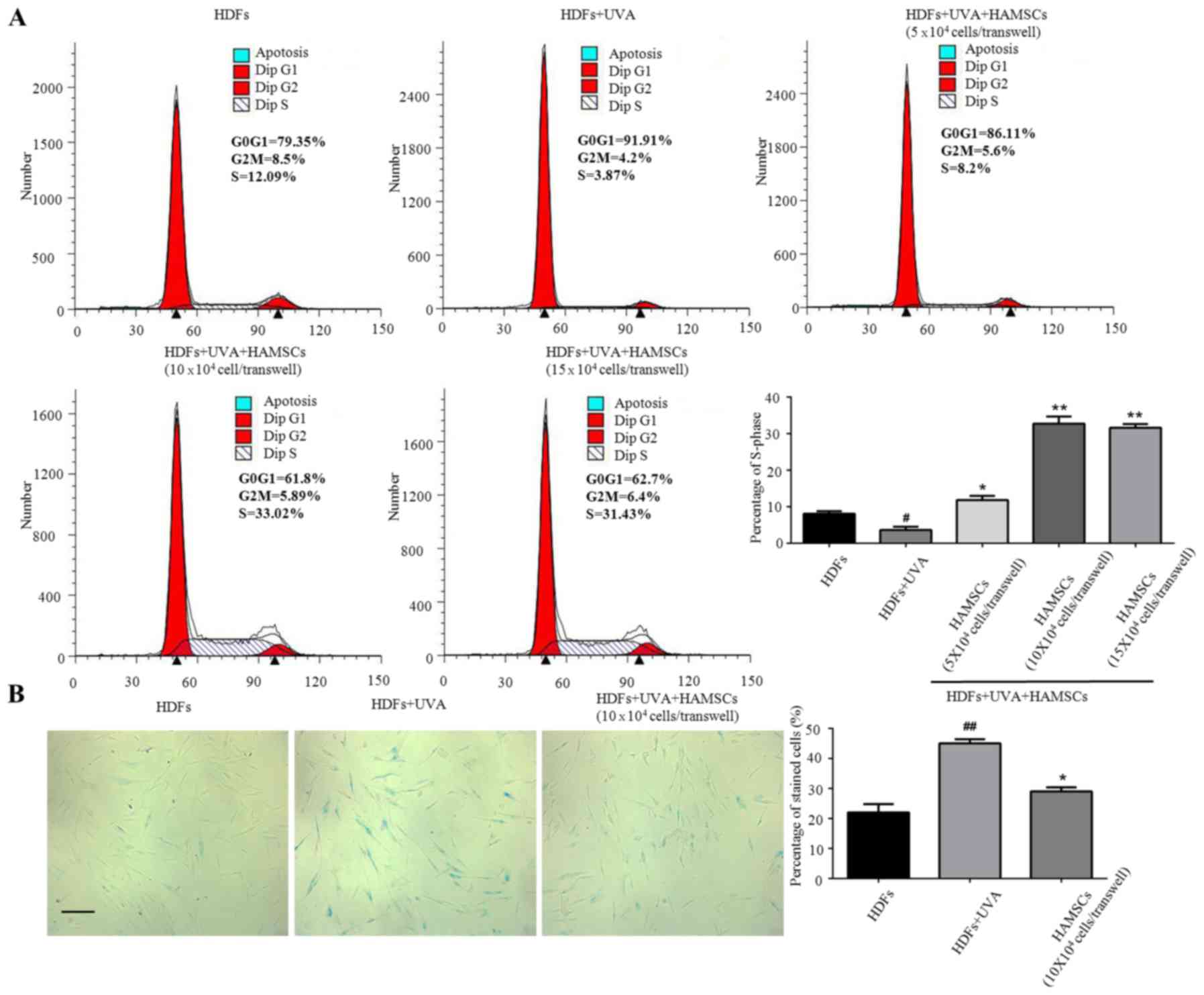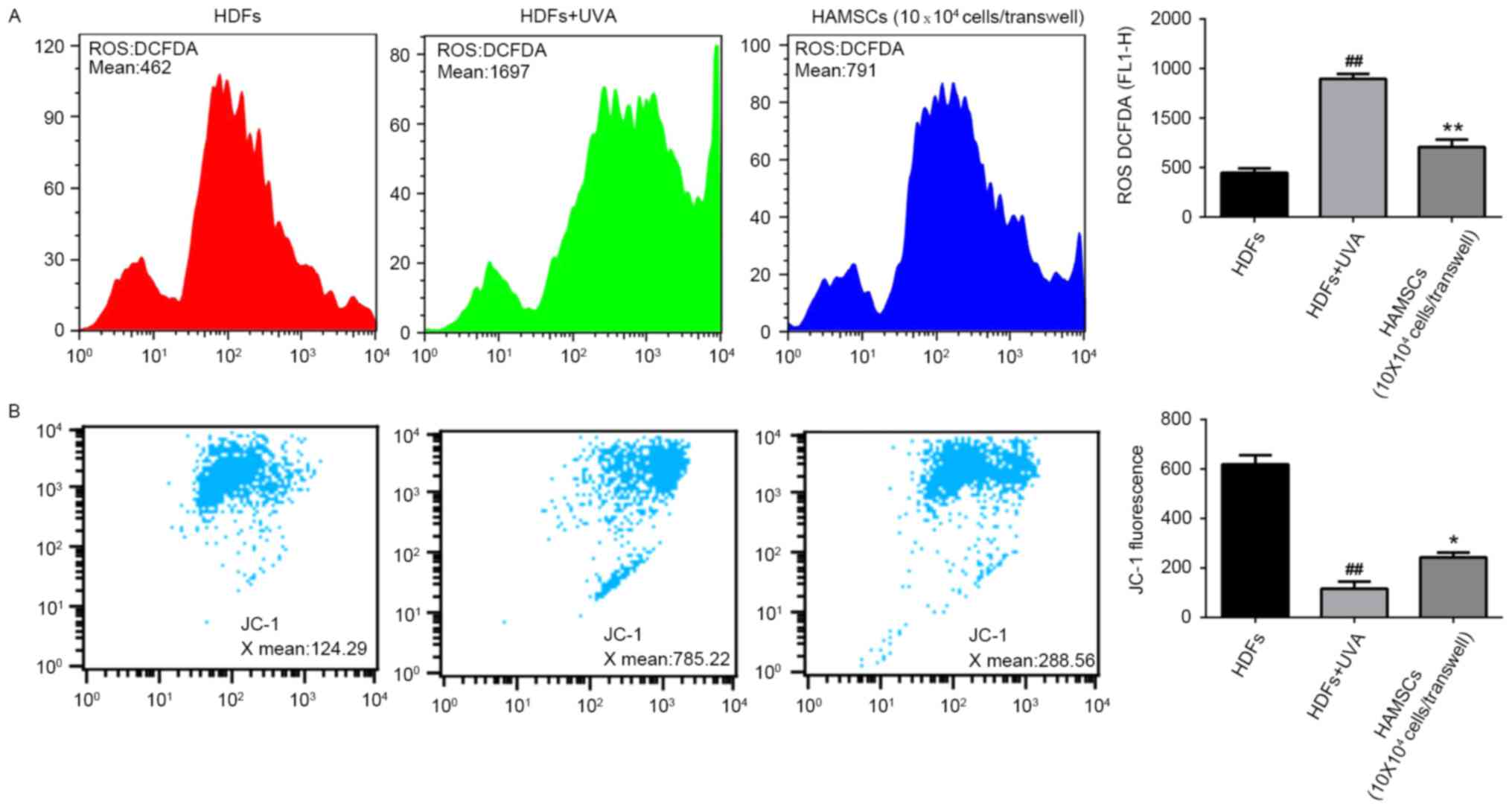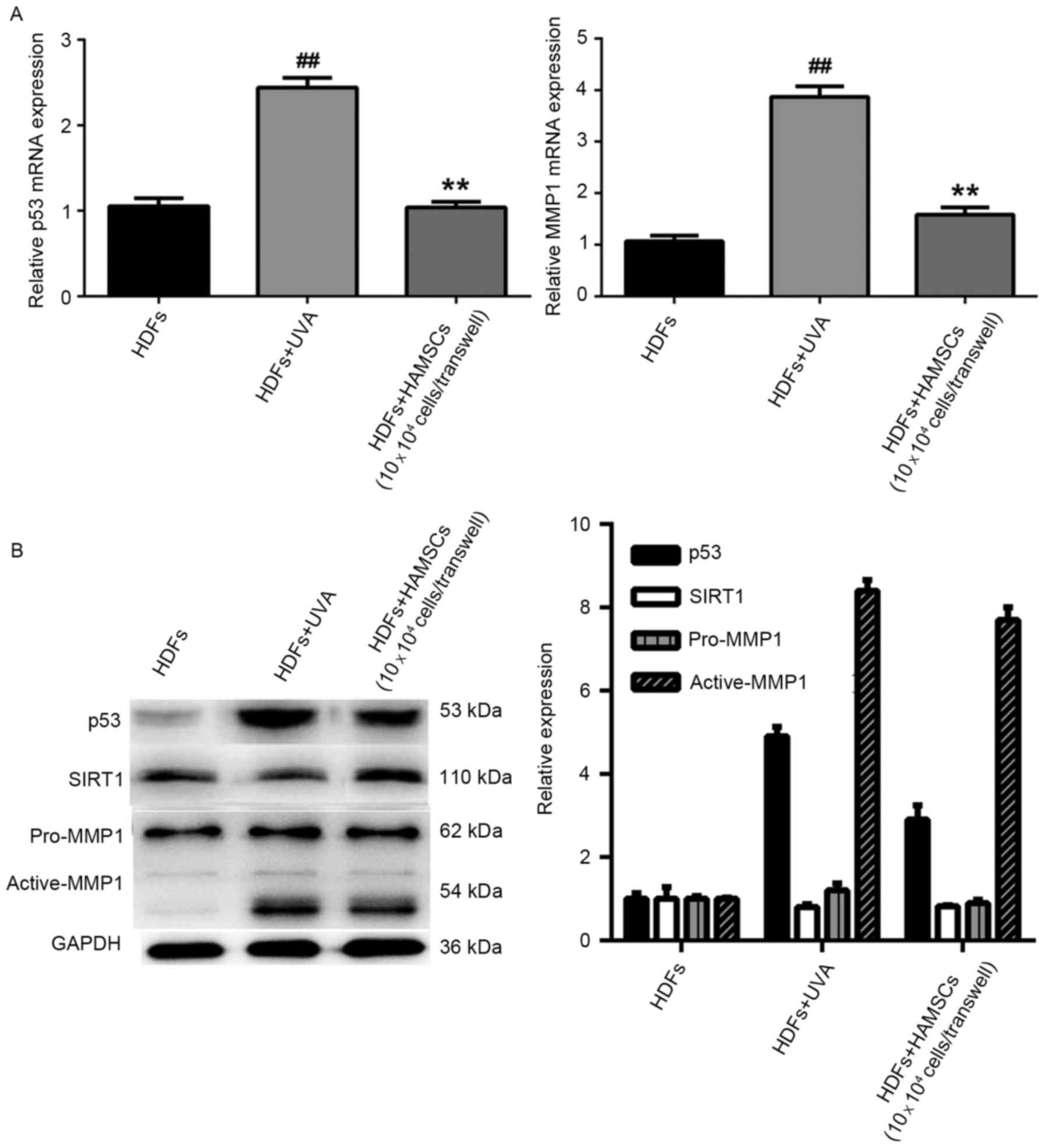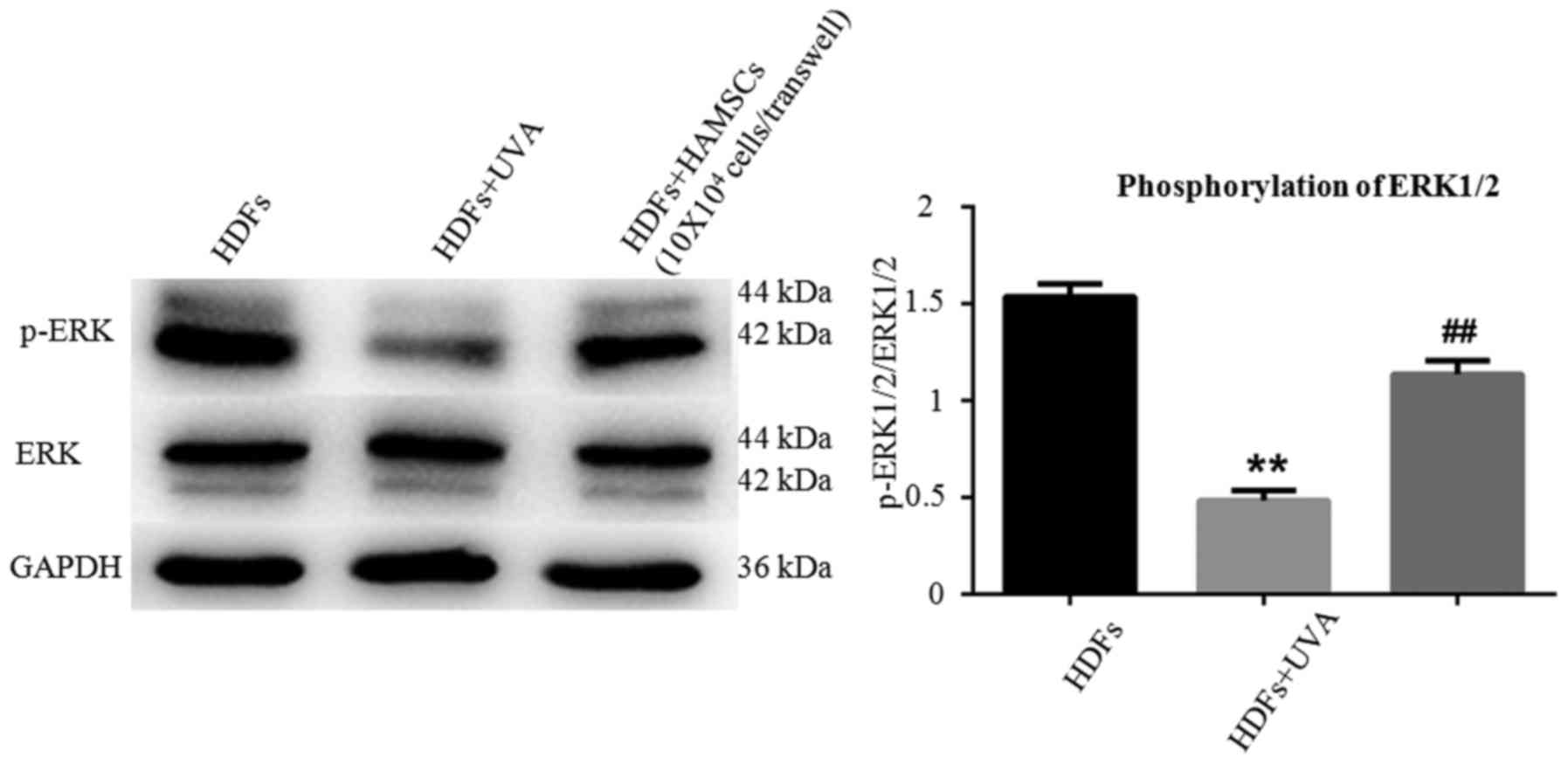|
1
|
He YY, Council SE, Feng L and Chignell CF:
UVA-induced cell cycle progression is mediated by a disintegrin and
metalloprotease/epidermal growth factor receptor/AKT/Cyclin D1
pathways in keratinocytes. Cancer Res. 68:3752–3758. 2008.
View Article : Google Scholar : PubMed/NCBI
|
|
2
|
Morita A, Grewe M, Grether-Beck S,
Olaizola-Horn S and Krutmann J: Induction of proinflammatory
cytokines in human epidermoid carcinoma cells by in vitro
ultraviolet A1 irradiation. Photochem Photobiol. 65:630–635. 1997.
View Article : Google Scholar : PubMed/NCBI
|
|
3
|
Min W, Liu X, Qian Q, Lin B, Wu D, Wang M,
Ahmad I, Yusuf N and Luo D: The Effects of baicalin against
UVA-induced photoaging in skin fibroblasts. Am J Chin Med.
42:709–727. 2014. View Article : Google Scholar : PubMed/NCBI
|
|
4
|
Ilancheran S, Michalska A, Peh G, Wallace
EM, Pera M and Manuelpillai U: Stem cells derived from human fetal
membranes display multilineage differentiation potential. Biol
Reprod. 77:577–588. 2007. View Article : Google Scholar : PubMed/NCBI
|
|
5
|
Miki T, Lehmann T, Cai H, Stolz DB and
Strom SC: Stem cell characteristics of amniotic epithelial cells.
Stem Cells. 23:1549–1559. 2005. View Article : Google Scholar : PubMed/NCBI
|
|
6
|
Song YS, Joo HW, Park IH, Shen GY, Lee Y,
Shin JH, Kim H, Shin IS and Kim KS: Transplanted human amniotic
epithelial cells secrete paracrine proangiogenic cytokines in rat
model of myocardial infarction. Cell Transplant. 24:2055–2064.
2015. View Article : Google Scholar : PubMed/NCBI
|
|
7
|
Chen YT, Li W, Hayashida Y, He H, Chen SY,
Tseng DY, Kheirkhah A and Tseng SC: Human amniotic epithelial cells
as novel feeder layers for promoting ex vivo expansion of limbal
epithelial progenitor cells. Stem Cells. 25:1995–2005. 2007.
View Article : Google Scholar : PubMed/NCBI
|
|
8
|
Lai D, Wang Y, Sun J, Chen Y, Li T, Wu Y,
Guo L and Wei C: Derivation and characterization of human embryonic
stem cells on human amnion epithelial cells. Sci Rep. 5:100142015.
View Article : Google Scholar : PubMed/NCBI
|
|
9
|
Banas R, Miller C, Guzik L and Zeevi A:
Amnion-derived multipotent progenitor cells inhibit blood monocyte
differentiation into mature dendritic cells. Cell Transplant.
23:1111–1125. 2014. View Article : Google Scholar : PubMed/NCBI
|
|
10
|
Díaz-Prado S, Muiños-López E,
Hermida-Gómez T, Cicione C, Rendal-Vázquez ME, Fuentes-Boquete I,
de Toro FJ and Blanco FJ: Human amniotic membrane as an alternative
source of stem cells for regenerative medicine. Differentiation.
81:162–171. 2011. View Article : Google Scholar : PubMed/NCBI
|
|
11
|
Díaz-Prado S, Muiños-López E,
Hermida-Gómez T, Rendal-Vázquez ME, Fuentes-Boquete I, de Toro FJ
and Blanco FJ: Multilineage differentiation potential of cells
isolated from the human amniotic membrane. J Cell Biochem.
111:846–857. 2010. View Article : Google Scholar : PubMed/NCBI
|
|
12
|
Han K, Lee JE, Kwon SJ, Park SY, Shim SH,
Kim H, Moon JH, Suh CS and Lim HJ: Human amnion-derived mesenchymal
stem cells are a potential source for uterine stem cell therapy.
Cell Prolif. 41:705–725. 2008. View Article : Google Scholar
|
|
13
|
Onishi R, Onishi S, Higashi R, Yamahara K,
Yoshimatsu J, Katsurada T, Okubo N, Nakagawa K, Takeda H and
Sakamoto N: The anti-inflammatory effect of human annion-derived
mesenchymal stem cells. Placenta. 35:A232014. View Article : Google Scholar
|
|
14
|
Lee JH, Ryu IH, Kim EK, Lee JE, Hong S and
Lee HK: Induced expression of insulin-like growth factor-1 by
amniotic membrane-conditioned medium in cultured human corneal
epithelial cells. Invest Ophthalmol Vis Sci. 47:864–872. 2006.
View Article : Google Scholar : PubMed/NCBI
|
|
15
|
Ohno-Matsui K, Ichinose S, Nakahama K,
Yoshida T, Kojima A, Mochizuki M and Morita I: The effects of
amniotic membrane on retinal pigment epithelial cell
differentiation. Mol Vis. 11:1–10. 2005.PubMed/NCBI
|
|
16
|
Akrami H, Soheili ZS, Sadeghizadeh M,
Khalooghi K, Ahmadieh H, Kanavi MR, Samiei S and Pakravesh J:
Evaluation of RPE65, CRALBP, VEGF, CD68, and tyrosinase gene
expression in human retinal pigment epithelial cells cultured on
amniotic membrane. Biochem Genet. 49:313–322. 2011. View Article : Google Scholar : PubMed/NCBI
|
|
17
|
Yan ZJ, Zhang P, Hu YQ, Zhang HT, Hong SQ,
Zhou HL, Zhang MY and Xu RX: Neural stem like cells derived from
human amnion tissue are effective in treating traumatic brain
injury in rat. Nerochem Res. 38:1022–1033. 2013. View Article : Google Scholar
|
|
18
|
Nogami M, Tsuno H, Koike C, Okabe M,
Yoshida T, Seki S, Matsui Y, Kimura T and Nikaido T: Isolation and
characterization of human amniotic mesenchymal stem cells and their
chondrogenic differentiation. Transplantation. 93:1221–1228. 2012.
View Article : Google Scholar : PubMed/NCBI
|
|
19
|
Lim H, Han K, Lee J, Shim S, Moon J, Suh
C, Kim J and Kim H: Human amnion derived mesenchymal stem cells may
have potential to contribute and differentiate endometrial cells in
vivo. Hum Reprod. 22:i1712007.
|
|
20
|
Tamagawa T, Ishiwata I, Ishikawa H and
Nakamura Y: IInduced in-vitro differentiation of neural-like cells
from human amnion-derived fibroblast-like cells. Hum Cell.
21:38–45. 2008. View Article : Google Scholar : PubMed/NCBI
|
|
21
|
Niknejad H, Yazdanpanah G and Ahmadiani A:
Induction of apoptosis, stimulation of cell-cycle arrest and
inhibition of angionenesis make human amnion-derived cells
promising sources for cell therapy of cancer. Cell Tissue Res.
363:599–608. 2016. View Article : Google Scholar : PubMed/NCBI
|
|
22
|
Lei LT, Chen JB, Zhao YL, Yang SP and He
L: Resveratrol attenuates senescence of adipose-derived mesenchymal
stem cells and restores their paracrine effects on promoting
insulin secretion of INS-1 cells through Pim-1. Eur Rev Med
Pharmacol Sci. 20:1203–1213. 2016.PubMed/NCBI
|
|
23
|
Kawakubo K, Ohnishi S, Fujita H, Kuwatani
M, Onishi R, Masamune A, Takeda H and Sakamoto N: Effect of fetal
membrane-derived mesenchymal stem cell transplantation rats with
acute and chronic pancreatitis. Pancreas. 45:707–713. 2016.
View Article : Google Scholar : PubMed/NCBI
|
|
24
|
Ono M, Ohnishi S, Honda M, Ishikawa M,
Hosono H, Onishi R, Nakagawa K, Takeda H and Sakamoto N: Effects of
human amnion-derived mesenchymal stromal cell transplantation in
rats with radiation proctitis. Cytotherapy. 17:1545–1559. 2015.
View Article : Google Scholar : PubMed/NCBI
|
|
25
|
Li J, Koike-Soko C, Sugimoto J, Yoshida T,
Okabe M and Nikaido T: Human amnion-derived stem cells have
immunosuppressive properties on NK cells and monocytes. Cell
Transplant. 24:2065–2076. 2015. View Article : Google Scholar : PubMed/NCBI
|
|
26
|
Sahin E, Colla S, Liesa M, Moslehi J,
Müller FL, Guo M, Cooper M, Kotton D, Fabian AJ, Walkey C, et al:
Telomere dysfunction induces metabolic and mitochondrial
compromise. Nature. 470:359–365. 2011. View Article : Google Scholar : PubMed/NCBI
|
|
27
|
Hengartner MO: The biochemistry of
apoptosis. Nature. 407:770–776. 2000. View
Article : Google Scholar : PubMed/NCBI
|
|
28
|
Vogelstein B, Lane D and Levine AJ:
Surfing the p53 network. Nature. 408:307–310. 2000. View Article : Google Scholar : PubMed/NCBI
|
|
29
|
Sreedhar R, Giridharan W, Arumugam S,
Karuppagounder V, Palaniyandi SS, Krishnamurthy P, Quevedo J,
Watanabe K, Konishi T and Thandavarayan RA: Role of MAPK-mediated
endoplasmic reticulum stress signaling in the heart during aging in
senescence-accelerated prone mice. Biofactors. 42:368–375. 2016.
View Article : Google Scholar : PubMed/NCBI
|


















